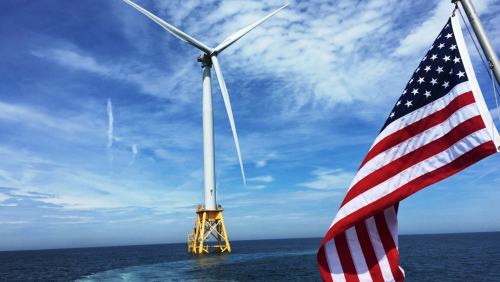Untapped Potential: Support for the U.S. Offshore Wind Industry at an All-Time High
January 31, 2023 by Reilly Wright

An offshore wind turbine is seen rising out of the ocean with an American flag flying on the back of a boat passing by.
Offshore wind has been a viable energy source internationally for many years. Historically, the United Kingdom, Germany, and Denmark lead the industry’s technological development, but China is expected to have the largest cumulative installed offshore wind capacity globally by the end of 2022.[1] The International Energy Agency reports that nations are not even close to tapping offshore wind’s full potential.[2] The global offshore wind market has the potential to produce over 420,000 terawatt hours (TWh) per year worldwide, which is over 18 times the global energy demand today.[3]
The United States has one of the highest estimated achievable energy generation capacities for offshore wind, otherwise known as technical potential, at 8,086 TWh per year, second only to the European Union.[4] This is double the amount of electricity consumed by Americans in 2019 and ninety percent of projected energy consumption in 2050, even if the entire national economy were electrified.[5] Despite its expansive coastlines and technological potential, the U.S. has not yet adopted this energy source on the scale of other nations.
However, the U.S. offshore wind market is undoubtedly on the rise. According to the U.S. Department of Energy (DOE), the U.S. offshore wind energy development pipeline grew to a potential generating capacity, or the expected amount of energy that can be generated from a particular source, of 40,083 megawatts (MW) as of May 2022.[6] This is a 13.5% increase from the 2021 projection pipeline, which is largely due to the addition of eight new lease areas recently auctioned by the U.S. Bureau of Ocean Energy Management (BOEM) in the Atlantic Ocean. While most projects are located in the Northeastern and Mid-Atlantic states, new areas are being leased off the coast of California and in the Gulf of Mexico. Only two farms are currently operational: the 30-megawatt (MW) Block Island Wind Farm and the 12-MW Coastal Virginia Offshore Wind pilot project.[7] However, eighteen projects in the U.S. offshore pipeline are in the permitting phase, and eight states have set their own offshore wind energy procurement goals, which total 40 gigawatts (GW) by 2040.[8]
Federal government support for offshore wind in the United States is currently at an all-time high. The Biden Administration has vocally pushed for the development of the domestic offshore wind industry, announcing an ambitious goal of 30 GW of offshore wind power by 2030.[9] The recent passing of the Inflation Reduction Act (IRA) provides unprecedented congressional support for offshore wind. The IRA grants $100 million for convening stakeholders and conducting analysis related to interregional transmission development and the development of transmission for offshore wind energy.[10] Tax credit provisions in the IRA give offshore wind project developers a thirty percent tax credit for projects that begin construction before January 1, 2026.[11]
New federal government support and economic incentives indicate that offshore wind is a promising source of renewable energy for the nation. However, the emerging U.S. offshore wind industry still faces issues concerning transmission, cost uncertainty, critical mineral supply, and NIMBY opposition.[12] Only time will tell if the economic incentives provided by the IRA and the Biden Administration’s support will be strong enough to outweigh the costs of developing U.S. offshore wind farms in the foreseeable future.
[1] Renewable Energy Market Update, Outlook for 2022 and 2023, International Energy Agency, 7 (May, 2022), https://iea.blob.core.windows.net/assets/d6a7300d-7919-4136-b73a-3541c33f8bd7/RenewableEnergyMarketUpdate2022.pdf
[2] Offshore Wind Outlook 2019, International Energy Agency (Nov. 2019) https://www.iea.org/reports/offshore-wind-outlook-2019.
[3] Id.
[4] Id.
[5] Bryn Huxley-Reicher & Hannah Read, Offshore Wind for America, Frontier Group (Mar. 18, 2021) https://frontiergroup.org/resources/offshore-wind-america/
[6] Philipp Beiter, et al., Offshore Wind Market Report: 2022 Edition, U.S. Department of Energy, vi, (Aug. 2022) https://www.energy.gov/sites/default/files/2022-08/offshore_wind_market_report_2022.pdf
[7] WINDExchange: Offshore Wind Energy, Office of Energy Efficiency & Renewable Energy, https://windexchange.energy.gov/markets/offshore
[8] Id.
[9] Biden-Harris Administration Announces New Actions to Expand U.S. Offshore Wind Energy, The White House, (Sept. 15, 2022) https://www.whitehouse.gov/briefing-room/statements-releases/2022/09/15/fact-sheet-biden-harris-administration-announces-new-actions-to-expand-u-s-offshore-wind-energy/#:~:text=The%20President%20set%20a%20bold,and%20down%20the%20supply%20chain.
[10] Corrie E. Clark et. al., Offshore Wind Provisions in the Inflation Reduction Act, Congressional Research Service, 1-2 (Sep. 29, 2022) https://crsreports.congress.gov/product/pdf/IN/IN11980#:~:text=Section%2013502%20of%20the%20IRA,10%25%20of%20the%20sales%20price
[11] Id.
[12] See, Jonathan Lesser, Out to Sea: The Dismal Economics of Offshore Wind, Manhattan Institute, 5,(Aug. 2020), https://media4.manhattan-institute.org/sites/default/files/out-to-sea-dismal-economics-offshore-wind-JL.pdf
Briefly define this term within the blog (and be sure to cite any additional sources used to create that definition)

